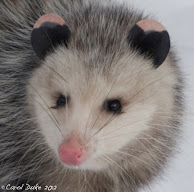Spring showers us with a profusion of petals, tepals and sepals, as well as scores of tweets and twitters of slight silvery songbirds.
Many birds can live up to fifteen years or more and often return to the same favored nesting grounds. It is very likely then, that many of the songbirds who raise their young here, in the gardens, fields and forest of Flower Hill Farm, are 'coming home' each spring, to their habitat of choice.
I so look forward to this recurring ritual and when I begin to hear the chirruping and chirring in the shrubberies and trees, my heart truly races with my mind to recall the face and colorful markings that matches each trilling. Around 1766 Carl Linnaeus gave the name Geothlypis trichas Common Yellowthroat Warbler, to this little masked bird. When I hear its " wich-i-ty, wich-i-ity, wich-i-ity," I run for my camera and try to find this flighty tiny warbler.
I will not usually look high in the trees, for the Common Yellowthroat prefers flitting and nesting about in the lower areas of the open fields and gardens. I might see them on the bottom branches of shrubs, such as blueberries, or in amongst plants, brush or briars. I have never seen their nests, which are small cups within tufts of grass or plants, very near or on the ground. These boldly patterned warblers are mostly insectivores, busily gleaning shrubberies and plants and occasionally finding seeds to their liking. They would sooner be near wetland and water, thus must enjoy the several seasonal streams and a solitary spring hidden within the forest here.
They can be very shy! Do you see an eye?
The only thing common about this warbler is that it is known to nest all throughout Canada, the United States and even into northern Mexico, while wintering across the southern United States, Northern South America and the West Indies. There are at least nine other species of Yellowthroats found mostly in Mexico.
 |
| Female Common Yellowthroat |
The male helps to rear his young.
Cowbirds and loss of habitat are a threat, but there is at present no real concern for the Common Yellowthroat.
Sweet peeps let him know where to find his fledgling.
Both parents work hard all day, finding morsels of food.
Papa can relax a bit now and then.
This delightful, beneficial bird needs a special habitat, so do consider caring wisely for land and wildlife. There is a frightening loss of habitat each day and everything we do to rebuild native, natural surroundings will help all wildlife, most especially our feathered friends.
Gail over at Clay and Limestone is a great champion for all things wild. Today she invites you to share Wildflower Wednesday. I hope you have time to take a walk on the wild side. You will be glad for the visit!



































































.jpg)



































































